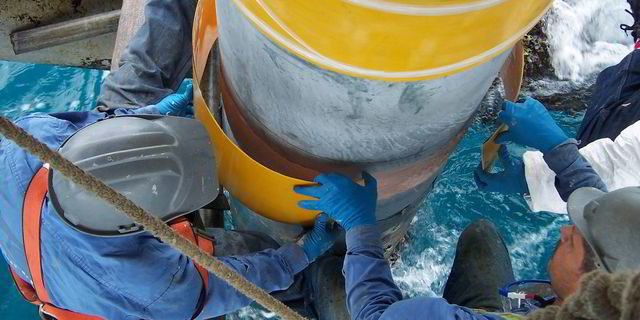Seeing the need to help the industry preserve critical infrastructure for decades, Clock Spring is on a drive to develop and enhance technologies and improve installation processes for composite pipeline repair.
Buddy Powers, vice president for product management and technical services, says the 25-year-old company known for its eponymous Clock Spring composite repair sleeves has turned its focus to innovating.
“We are taking the products we have now and enhancing them, and developing new products that are synergistic to what we do, which is structurally reinforce critical infrastructure,” Powers says. Clock Spring sleeves can be applied in situations where a pipeline is suffering from corrosion as well as dents and other degradations.

The repair sleeves can be used in nearly all ditch conditions onshore, underwater and even on condensing pipes, Powers says.
The technology is unsuitable for situations where the surface cannot be properly prepared, which would lead to issues with bonding or sealing. It also cannot be used on concrete.
The repair sleeves are typically used to address general corrosion, wall loss, dents, and axial-oriented defects such as cracks and seam flaws.
The sleeves work by constraining weak or damaged pipe. Together, the composite and pipe wall structurally reinforce the pipe to control pressure within the pipe.The company manufactures all the Clock Spring composite materials at its Houston facility. The composite coil has a shape memory.
It is made from glass fibres and wound through a bath of polyester resin, the same material used for underground storage tanks.
During manufacturing, the composite is wound around a mandrel smaller than the diameter of the pipe it is made for and air-cured for 24 hours.
Following the air cure, it is heat treated in an oven at temperatures greater than 180 degrees Fahrenheit to secure the mechanical properties.
Because of its shape memory from its time on the mandrel, it will wind tightly onto the pipeline.
Most composite repair materials, Powers says, are field-cured, a process that requires a weather window and specially trained personnel. Improper installation can result in an incomplete corrosion barrier.
The Clock Spring components can be installed in ambient temperatures from -20 to 120 degrees Fahrenheit (-29 to 49 degrees Celsius) with operational temperatures up to 250 degrees F (121 degrees C). Improving installation ease is a cornerstone of the company’s work, Powers says.
“Clock Spring is trying to basically take the approach that it can develop and enhance current technologies and processes to reinforce critical infrastructure so that it’s easy to install, cost-effective to deploy and durable for decades.”
The company is working to validate its improvements with industry partners.
“We’re also pushing the boundaries of ways we can support higher temperatures and safer installation practices,” Powers says.
This is critical in rope access situations for risers. The goal is to limit the amount of time and number of personnel required on site for repairs. “Less time is safer,” he says.
Clock Spring sleeves were recently used to repair a dented subsea pipeline. While running an inline inspection tool through the pipeline in water depths of 30 feet (nine metres), a client found a “massive amount of dents” caused by a dragged anchor or a barge, Powers says.
Following a critical engineering assessment, divers applied filler, adhesive and Clock Spring sleeves to the dented areas to structurally reinforce the pipeline.
The same acrylic adhesive is used both for air or water applications. “It cures quickly,” Powers says, noting that the adhesive reaches 90% strength under water or on land within two hours, allowing pipeline operators the opportunity to resume throughput on the pipeline more quickly. Standard epoxy adhesives, he says, can take eight to 24 hours to cure.
An incompressible filler is applied to the defective area of the pipeline, so the pipe wall will transfer stresses through the fill material to the composite.
The Clock Spring sleeve is placed around the pipe. Each layer adheres with the acrylic-based glue, and the composite repair is tightened with a torqueing bar.
Clock Spring sleeves are 12 inches long. A sleeve for a 12-inch outside diameter pipe weighs around 20 pounds (nine kilograms), while a sleeve for a 30-inch outside diameter pipe is around 50 pounds.
“These are easily passed around the pipe. They are not heavy at all,” Powers says.
In the case of tight access, the sleeve can be spooled onto the pipe away from the defect area, slid over the damage and tightened. Tight access is one of the main reasons a secondary technology, Snap Wrap, was developed. Made of the same composite, adhesive and filling materials as Clock Spring, Snap Wrap is easier to install in rope access and offshore applications, Powers says.
Installation calls for opening the Snap Wrap shells and snapping them around a pipeline, sequentially, to create the required thickness for the repair. The shells are then tightened and cured.
The company is working to enhance the Snap Wrap offering by making the sleeves longer to cover more linear feet, he says.
While the company came into existence in the early 1990s, research into what became the company’s foundational technology began earlier. In the 1980s, the Gas Research Institute directed a programme to verify the effectiveness, durability and performance characteristics of the repair method.
It was a long road to gain acceptance that a composite could be as – or more – durable than steel.
“A lot of questions needed to be answered,” he says.
The results came out of a decade-long testing programme that verified the viability of the product as an alternative to traditional pipeline repair methods, which required cutting, removing and replacing degraded pipeline, and welding.
“That had tremendous impact on the people working on the pipeline and the operators, from shutting down the line to hot working around hydrocarbons to the heavy equipment around the dig sites and excavations,” Powers says.
“This composite technology offered an alternative. It revolutionised the way pipeline operators approached the repair of pipelines. It changed how people looked at pipeline repair.”

